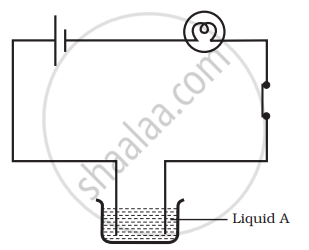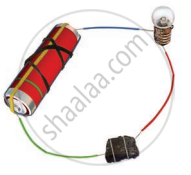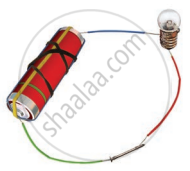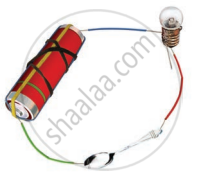Advertisements
Advertisements
Question
Paheli set up an experiment using liquid A in the beaker as shown in the figure. She observed that the bulb glows. Then, she replaced the liquid A by another liquid B. This time the bulb did not glow. Boojho suggested replacing the bulb by an LED. They observed that the LED glows. Explain.

Solution
Liquid A is a good conductor of electricity and it allows the maximum current to pass through it which is sufficient to glow the bulb.
But when it is replaced by another liquid B, bulb does not glow because the current through liquid B could be weak and therefore unable to make the bulb glow.
But the small current which is passing through B is sufficient to glow a low voltage LED, so it glows.
APPEARS IN
RELATED QUESTIONS
The passage of an electric current through a solution causes ______ effects.
When electric current is passed through a conducting solution, there is a change of colour of the solution. This indicates
Which of the following metals is used in electroplating to make objects appear shining?
Observe the following circuits carefully. In which circuit will the bulb glow? Write Yes or No in the blank space provided along each of the circuit given in the figure.
|
(a) |
Piece of coal |
______ |
|
(b) |
Iron nail |
______ |
|
(c) |
Eraser |
______ |
|
(d) |
Steel spoon |
______ |
You are provided with a magnetic compass, an empty matchbox, a battery of two cells and connecting wires. Using these objects, how will you make a tester for testing an electric circuit? Draw the necessary circuit diagram and explain.
A chemical reaction happens when electricity passes through various conducting liquids.
The most common industrial application of chemical effects of electric current is ______.
Liquids that conduct electricity are the solutions of ______.
Name the process which shows the chemical effect of electric current?
State some advantages of electroplating.




